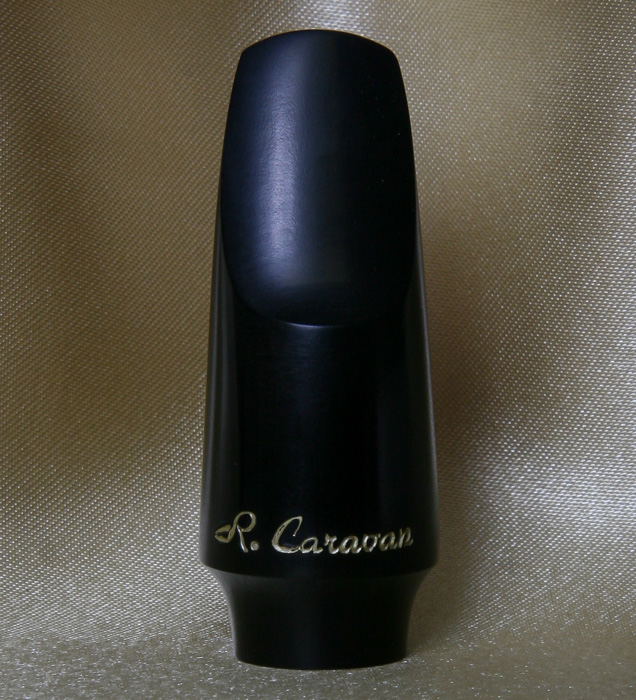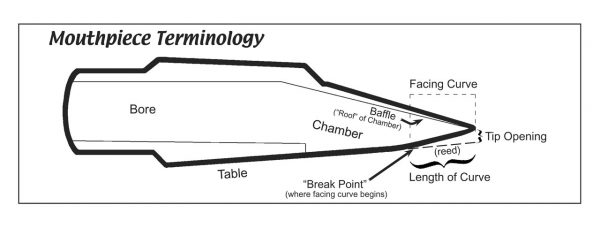Caravan Sopran Saxophon Mundstück
Das Caravan Sopransaxophon-Mundstück hat sich zu einer der beliebtesten Alternativen für die „klassische“ Performance auf dem Sopransaxophon entwickelt. Das Design mit offener Kammer bietet eine ausreichend große Tonkammer, um eine tiefe, dunkle Qualität mit außergewöhnlicher harmonischer Balance zu erzeugen, aber nicht so groß, dass es an Projektion mangelt. Die Mundstücköffnung ist mit etwa 0,044 Zoll an der Spitze des Mundstücks mittelgroß.
Das Ronald Caravan Saxophon Mundstück
Ronald L. Caravan: „Erhältlich für Sopran-, Alt-, Tenor- und Baritonsaxophone, stellt dieses Mundstück eine moderne Manifestation des ursprünglichen Mundstückdesigns von Adolphe Sax dar. Die Charakteristik der „offenen Kammer“ (keine Konstruktion in der Tonkammer) sorgt für eine beträchtliche klangliche Tiefe und eine dunkle Qualität für die „klassische“ Performance auf dem Saxophon, aber die Tonkammer ist auch so dimensioniert, dass sie im Vergleich zu älteren Designs mit offener Kammer viel Kraft und Fülle bietet. Der wunderbar ausgewogene Klang, den dieses Mundstück erzeugen kann, kommt in erster Linie von der tiefen Schallwand und der runden Tonkammer, die sich nahtlos in die Mundstückbohrung einfügt. Breitere Seiten- und Spitzenschienen sorgen für eine größere Reinheit des Tons und eine größere Homogenität der Farbe im gesamten Tonumfang des Saxophons.
Dieses Saxophonmundstück wurde entwickelt, um es dem Saxophonisten zu erleichtern, eine Klangqualität zu erzeugen, die den Klängen entspricht, die man bei anderen Holzbläsern in der symphonischen und klassischen Musik in Amerika hört – ein „amerikanischer“ Klang, der mehr oder weniger eine Synthese verschiedener europäischer „Schulen“ darstellt. Der Klang, den dieses Mundstück fördert, ist eine besonders attraktive Alternative zu den helleren Klängen, die im Allgemeinen mit der französischen Schule und den Mundstückcharakteristiken, die diese Ergebnisse hervorbringen, assoziiert werden – ein Klangkonzept, das im Allgemeinen bei anderen Symphoniemusikern in diesem Land keinen Anklang findet.“
The Caravan Soprano Saxophone Mouthpiece
The Caravan Soprano Saxophone Mouthpiece has become one of the profession’s most popular alternatives for “classical” performance on soprano saxophone. The open-chamber design features a large enough tone chamber to produce a deep, dark quality of exceptional harmonic balance, but not so large that it lacks projection. The tip opening is medium-close at around .044 in. at the very tip of the mouthpiece (not at the inside of the tip rail as most hand-held gauges measure tip opening), and the facing curve is exclusive but well within conventional parameters for a “classical” soprano mouthpiece.
The Ronald Caravan Saxophone Mouthpiece
Ronald L. Caravan: „Available for soprano, alto, tenor and baritone saxophones, this mouthpiece represents a modern manifestation of Adolphe Sax´s original mouthpiece design. The „open chamber“ characteristic (no construction in the tone chamber) provides for considerable tonal depth and darkness in quality for „classical“ performance on saxophone, but the tone chamber is also sized to allow for plenty of power and richness compared with older open-chamber designs. The beautifully balanced sound this mouthpiece can produce comes primarily from the deep baffle and round tone chamber that blends smoothly into the bore of the mouthpiece. Wider side and tip rails provide for greater purity in the tone and greater homogenity of color throughout the saxophone´s range.
This saxophone mouthpiece has been designed to make it easier for the saxophonist to produce a tone quality that corresponds appropriately to the sounds heard among other woodwind performers in symphonic and classical music in America – an „American“ sound representing, more or less, a syntesis of various European „schools.“ The sound this mouthpiece encourages is a particularly attractive alternative to the brighter, „brassier“ sounds generally associated with the French school and the mouthpiece characteristics that produce those results – a sound concept generally not found favour among other symphony musicians in this country.“



